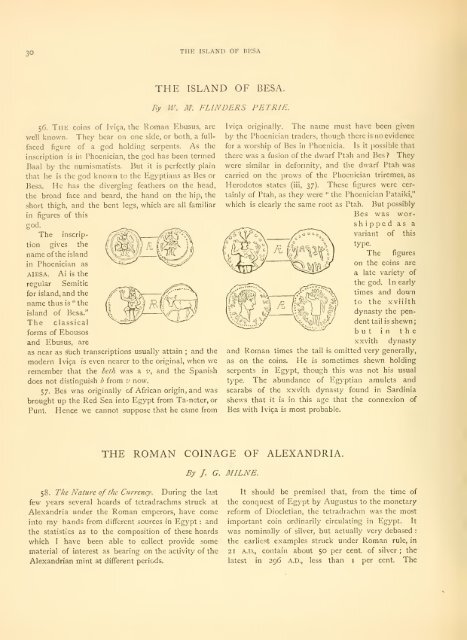Historical studies
Historical studies
Historical studies
Create successful ePaper yourself
Turn your PDF publications into a flip-book with our unique Google optimized e-Paper software.
30<br />
56. The coins of Iviga, the Roman Ebusus, are<br />
well known. They bear on one side, or both, a full-<br />
faced figure of a god holding serpents. As the<br />
inscription is in Phoenician, the god has been termed<br />
Baal by the numismatists. But it is perfectly plain<br />
that he is the god known to the Egyptians as Bes or<br />
Besa. He has the diverging feathers on the head,<br />
the broad face and beard, the hand on the hip, the<br />
short thigh, and the bent legs, which are all familiar<br />
in figures of this<br />
god.<br />
The inscrip-<br />
tion gives the<br />
name of the island<br />
in Phoenician as<br />
AIBSA. Ai is the<br />
regular Semitic<br />
for island, and the<br />
name thus is " the<br />
island of Besa."<br />
The classical<br />
forms of Ebousos<br />
and Ebusus, are<br />
as near as such transcriptions usually attain ;<br />
THE ISLAND OF BESA<br />
THE ISLAND OF BESA.<br />
By U-. M. FLINDERS PETRIE.<br />
and the<br />
modern Ivi^a is even nearer to the original, when we<br />
remember that the beth was a v, and the Spanish<br />
does not distinguish l? from 'j now.<br />
57. Bes was originally of African origin, and was<br />
brought up the Red Sea into Egypt from Ta-neter, or<br />
Punt Hence wc cannot suppose that he came from<br />
Ivi^a originally. The name must have been given<br />
by the Phoenician traders, though there is no evidence<br />
for a worship of Bes in Phoenicia. Is it possible that<br />
there was a fusion of the dwarf Ptah and 13es? They<br />
were similar in deformity, and the dwarf Ptah was<br />
carried on the prows of the Phoenician triremes, as<br />
Herodotos states (iii, 37). These figures were cer-<br />
tainly of Ptah, as they were " the Phoenician Pataiki,"<br />
which is clearly the same root as Ptah. But possibly<br />
Bes was worshipped<br />
as a<br />
variant of this<br />
type.<br />
The figures<br />
on the coins are<br />
a late variety of<br />
the god. In early<br />
times and down<br />
to the xviiith<br />
dynasty the pen-<br />
dent tail is shewn;<br />
but in the<br />
xxvith dynasty<br />
and Roman times the tail is omitted very generally,<br />
as on the coins. He is sometimes shewn holding<br />
serpents in Egypt, though this was not his usual<br />
type. The abundance of Egyptian amulets and<br />
scarabs of the xxvith dynasty found in Sardinia<br />
shews that it is in this age that the connexion of<br />
Bes with Ivica is most probable.<br />
THE ROMAN COINAGE OF ALEXANDRIA.<br />
58. The Nature of t/ie Currency!. During the last<br />
few years several hoards of tetradrachms struck at<br />
Alexandria under the Roman emperors, have come<br />
into my hands from different sources in Egypt : and<br />
the statistics as to the composition of these hoards<br />
which I have been able to collect provide some<br />
material of interest as bearing on the activity of the<br />
Alexandrian mint at different periods.<br />
By J. G. MILNE.<br />
It should be premised that, from the time of<br />
the conquest of Egypt by Augustus to the monetary<br />
reform of Diocletian, the tctradrachm was the most<br />
important coin ordinarily circulating in Egypt. It<br />
was nominally of silver, but actually very debased :<br />
the earliest examples struck under Roman rule, in<br />
21 A.D., contain about 50 per cent, of silver ; the<br />
latest in 296 A.D., less than i per cent. The

















